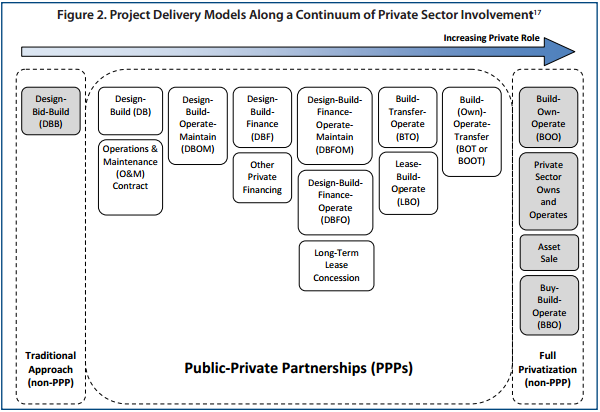
These days, if you listen to almost any politician or talk to almost anyone who works in the public sector, you will invariably hear the term “public private partnership” (P3). Strictly speaking, a P3 is any contractual agreement between a public agency (federal, state or local) and a private sector entity. P3s can be found in a broad range of industries, from schools to hospitals to surface transportation and ports. Despite the apparent ubiquity of P3 types and industries, there are some basic relationship structures that are commonly seen in surface transportation.
While technically speaking the traditional Design-Bid-Build approach (in which public agencies design a project and then enter into an agreement with a private enterprise to build the project) constitutes a “public-private partnership,” more recently, the current usage of P3 implies the transfer of more responsibility to the private partner than Design-Bid-Build.
The oft-stated basis for P3s is that they allow private companies to take on traditionally public roles in infrastructure projects, and they can both 1) keep the public sector ultimately accountable for a project and the overall service to the public and 2) cut costs through the private sector’s efficiencies and abilities to better manage risk.
Despite the strong push for P3s, some have suggested they’re not all they’re cracked up to be.
Laura Barrett, Executive Director of the Transportation Equity Network notes several problems, including stifled competition and the public sector being saddled with risk.
And according to Professor Matti Siemiatycki of the University of Toronto, P3s bring up concerns about limited public engagement — the pretext of commercial confidentiality can be used as a shield — and they tend not to result in sustainable transportation projects:
In cities […] 70 percent of all urban transportation PPPs delivered globally have been roads, bridges and tunnels that support greater dependence on the automobile, compared with just 30 percent of projects being urban and commuter rail lines that provide viable travel alternatives to the automobile.
On top of that, P3s can be more costly. Another study by Siemiatycki and researcher Naeem Farooqi of 28 Ontario P3 projects worth more than $7-billion, found that public-private partnerships cost an average of 16 percent more than conventional tendered contracts and that no “empirical evidence is provided to substantiate the risk allocations, making it difficult to assess their accuracy and validity.”
If anything is clear from reviewing the P3 literature, it’s that there is no certainty that P3s are a better choice than traditional procurement. Rather, each project comes with its own special circumstances. New York State Comptroller Thomas DiNapoli recently released a report that recommends creating a specialized entity to oversee P3 agreements and requiring independent evaluations of P3 cost-benefit analyses. Accordingly, if P3s do come into more frequent use in New York, New Jersey or Connecticut, all of these issues must be addressed with public understanding, analysis and engagement being paramount.

Worse than that, PPP circumvents public disclosure requirements, transparency and accountability.
In Stamford, the residents were told nothing about the bids that came in for the train station parking project until the winner was selected. How this is legal is beyond me and must be put to a stop.
I will oppose any and all projects in my city that are the result of a secret PPP process. Anyone who promotes smart streets, TOD etc. should be very concerned about this. Projects will be saddled by mistrust and public opposition from inception due to this criminal process.
[…] On Average, Public-Private Partnerships Cost More Than Traditional Procurement (MTR) […]